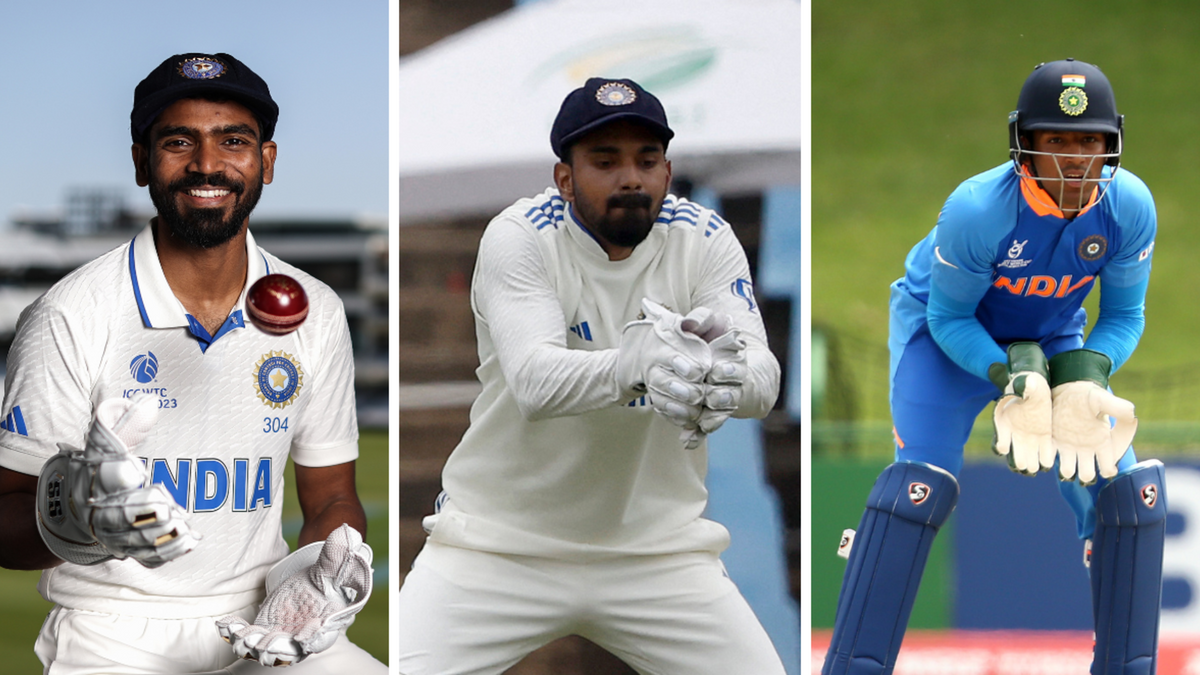
India have included KS Bharat, KL Rahul, and Dhruv Jurel for the first two Test matches against England, but who among them will start the series as their wicketkeeper?
Subscribe to the Wisden Cricket YouTube channel for post-match analysis, player interviews, and much more.
Uncapped Uttar Pradesh gloveman Dhruv Jurel was among the three wicketkeepers in the Indian squad for the first two Tests of their five-match series against England, along with KS Bharat and KL Rahul.
A year ago, not too long after Rishabh Pant’s horrific accident, India were left to choose between the uncapped Bharat and Ishan Kishan for the Border-Gavaskar Trophy. They preferred Bharat on that occasion.
A year later, ahead of the England series at home, they face a similar conundrum – Pant will not return to cricket until at least the IPL – though this time, the contest is a three-way affair and this time does not include Kishan.
KS Bharat
The selectors picked Bharat for the four home Tests against Australia as well as the World Test Championship final. Bharat was tidy and efficient behind the stumps.
Unfortunately, he made only 129 runs at 18.42 across these five games, of which 44 came in one innings on a flat Ahmedabad pitch. At the same time, it must be mentioned that India made 113, 109, and 163 in three innings of the seven innings where he fell cheaply, and failed to reach 300 thrice more.
Pros: Wicketkeeping skills are seldom evident from basic scorecards, but the Indian selectors had their eyes on Bharat for some time. He has played 20 first-class matches for India A – starting in 2018 – and had travelled with the Test squad as Pant’s deputy. He has kept wicket in the Ranji Trophy since 2011/12, and few contemporary, fit glovemen in the world are as equipped or experienced in these conditions.
Cons: A first-class batting average of 36.40 is ordinary by contemporary Indian standards. If one removes his Test numbers, it increases – but to only 37.39. When India dropped him in Kishan’s favour in the West Indies, it was almost certainly because of Bharat’s batting.
KL Rahul
A poor run during the same Border-Gavaskar Trophy early last year led to Rahul being first stripped of the vice-captaincy and then dropped from the Test XI. Later in 2023, he was injured during the IPL.
However, he roared back into the ODI side with a deluge of runs at the World Cup – all while keeping wicket – and was picked for the Tests in South Africa. When Kishan opted out, India gambled by going into a Test match without a specialist gloveman: until that point, Rahul had started only one first-class match as wicketkeeper, in England in 2021, when Pant and Wriddhiman Saha were both unfit.
Rahul made a hundred for the ages in South Africa and – living up to his reputation for being inconsistent – failed twice. He also dropped a simple catch of Aiden Markram – something that did not hurt India, but could have.
His excellent batting form will almost certainly earn him a place in the XI, but it will probably be as a specialist batter: largely because of his lack of wicketkeeping experience on the spinning pitches of India.
Pros: Rahul will play the Test match, but if he can keep wicket, India can play an extra batter to boost their already deep batting line-up.
Cons: Rain had denied India eight points at Port of Spain, and South Africa 12 more at Centurion. To maximise their points, India will – keeping in tune with the WTC era – almost certainly prepare turning tracks, at least to begin with. Rahul has no experience of keeping in these conditions in first-class cricket.
Dhruv Jurel
Jurel played for India in the 2020 Under-19 World Cup, but Upendra Yadav’s move to Railways enabled him to don the gloves for Uttar Pradesh. He made a mammoth 249 in 2022/23 – but that was against Nagaland, one of the weaker teams of the Ranji Trophy. He also had an excellent outing in the 2023 IPL, striking at 172.
Pros: A rapid scorer who can alter the course of a low-scoring contests quickly. Not quite Pant, but the closest in the squad.
Cons: Only 15 first-class matches, including two as specialist bat, probably do not count for much. The average of 46.47 drops to 33.81 (below Bharat’s) when one removes that 249, his only score over 70.
Are their any hints?
It is unusual of a squad for two Test matches to include three wicketkeepers. It can be safely assumed that the actual count is two, and Rahul will be – barring emergencies – playing as a batter.
Bharat led India A in South Africa until he was drafted into the Test squad as Kishan’s replacement. When the England Lions arrived, both Bharat and Jurel played in the tour game at Ahmedabad. Bharat made 64 in 69 balls, while Jurel, who kept wicket, smashed a 38-ball 50.
In the unofficial ‘Test’ against the Lions, however, Bharat kept wicket (and made 15 in the first innings) while Jurel was dropped.
In conclusion
Rahul will play – but as a batter. One of Yashasvi Jaiswal, Shubman Gill, and Shreyas Iyer will miss out as a result.
Given the India A selections, Bharat seems ahead of Jurel in the race. With R Ashwin, Ravindra Jadeja, and Axar Patel certain to play, India had preferred Bharat’s glovework over Kishan’s batting a year ago. They may do that again.
To win Test matches, after all, a team needs to take twenty wickets. For that, they need their best bowlers and, to back them on difficult tracks, the most seasoned man behind the stumps. Jurel’s time will come, but Bharat seems the forerunner at this point.








